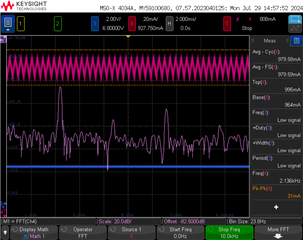- Ask a related questionWhat is a related question?A related question is a question created from another question. When the related question is created, it will be automatically linked to the original question.
This thread has been locked.
If you have a related question, please click the "Ask a related question" button in the top right corner. The newly created question will be automatically linked to this question.
Tool/software:
I have measured the following undesired phenomenon on a TPS922055DMTREVM evaluation board, where the 1A output current is modulated with 2,1 kHz. I have changed the sense resistor to 200 mOhm (1A) and the inductor from 10 uH (10) to 100 uH (1,53A).
The goal is to have a very low ripple current through the LEDs, and eventually use analog dimming over the full 1:256 range.
Magenta is the LED current measured with a 50 MHz current probe, pink is the FFT from 0 - 10 kHz showing the frequency of the ripple as a peak at 2,1 kHz. Blue is the ADIM voltage (constant 3,3V).
What can cause the 2,1 kHz ripple? I thought it might be the COMP setting, but also thought that it would only have higher frequency effects. Is my assumption correct?

Any help in resolving the low frequency ripple will be highly appreciated.
The modulation is caused by the spread spectrum feature of the TPS922055 device. I have searched the datasheet before for 2 kHz, but it is written as 2-kHz, hence did not deliver any matches. I will order the TPS922052 device, and all should be good.
8.3.1.2 Spread Spectrum
The TPS922053 and TPS922055 devices enable the spread spectrum feature (±7% from central frequency,
2-kHz modulation frequency) which reduces EMI noise at the switching frequency and its high-order harmonics.
On the other hand, the TPS922052 and TPS922054 devices disable the spread spectrum feature toward better
brightness performance in low brightness scenario.
Hi Anton,
The 2.1-kHz output current ripple you observed is most likely caused by the spread spectrum feature (2-kHz modulation frequency). Please refer to Section 8.3.1.2 from the datasheet.
If this is the case, then swapping the IC (TPS922055, default on the EVM) to a version without spread spectrum feature (TPS922052 or TPS922054) should eliminate this 2.1-kHz output current ripple.
Best Regards,
Steven